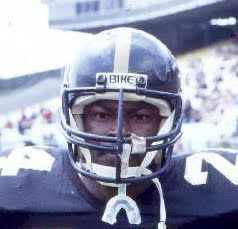
Ahmad Rashad
NOTE: Due to the adoption of the 16-game schedule as well as rules changes that had a major effect on opening up the passing game, the 1978 and ’79 seasons significantly skew the Top 10 results. Therefore, following the Top 10 is a list of the next 5 best performances that occurred exclusively from 1970-77.
TOP 10 RECEPTIONS
1- Rickey Young, 1978 Minnesota Vikings*
88 rec., 704 yards, 8.0 avg., 5 TD
2- Ahmad Rashad, 1979 Minnesota Vikings
80 rec., 1156 yards, 14.5 avg., 9 TD
3(tied)- Tony Galbreath, 1978 New Orleans Saints*
74 rec., 582 yards, 7.9 avg., 2 TD
3(tied)- Wallace Francis, 1979 Atlanta Falcons
74 rec., 1013 yards, 13.7 avg., 8 TD
5- Chuck Foreman, 1975 Minnesota Vikings*
73 rec., 691 yards, 9.5 avg., 9 TD
6- Rickey Young, 1979 Minnesota Vikings*
72 rec., 519 yards, 7.2 avg., 4 TD
7- Dick Gordon, 1970 Chicago Bears
71 rec., 1026 yards, 14.5 avg., 13 TD
8- Harold Carmichael, 1973 Philadelphia Eagles
67 rec., 1116 yards, 16.7 avg., 9 TD
9- Ahmad Rashad, 1978 Minnesota Vikings
66 rec., 769 yards, 11.7 avg., 8 TD
10-Wes Chandler, 1979 New Orleans Saints
65 rec., 1069 yards, 16.4 avg., 6 TD
* Running Back

Rickey Young
NEXT 5 (1970-77)
1- Charle Young, 1974 Philadelphia Eagles
63 rec., 696 yards, 11.0 avg., 3 TD
2(tied)- Harold Jackson, 1972 Philadelphia Eagles
62 rec., 1048 yards, 16.9 avg., 4 TD
2(tied)- Drew Pearson, 1974 Dallas Cowboys
62 rec., 1087 yards, 17.5 avg., 2 TD
4(tied)- Bob Tucker, 1971 New York Giants
59 rec., 791 yards, 13.4 avg., 4 TD
4(tied)- Charley Taylor, 1973 Washington Redskins
59 rec., 801 yards, 13.6 avg., 7 TD

Dick Gordon

Harold Carmichael
BEST BY FRANCHISES NOT IN TOP 10
St. Louis Cardinals: Pat Tilley, 1978
62 rec., 900 yards, 14.5 avg., 3 TD
Detroit Lions: Freddie Scott, 1979
62 rec., 929 yards, 15.0 avg., 5 TD
Green Bay Packers: Ken Payne, 1975
58 rec., 766 yards, 13.2 avg., 0 TD
San Francisco 49ers: Paul Hofer, 1979*
58 rec., 662 yards, 11.4 avg., 2 TD
Los Angeles Rams: Jack Snow, 1970
51 rec., 859 yards, 16.8 avg., 7 TD
Tampa Bay Buccaneers: Jimmie Giles, 1979**
40 rec., 579 yards, 14.5 avg., 7 TD
* Running Back
** Buccaneers joined NFL in 1976 as AFC team, moved to NFC in ‘77

Gene Washington

Harold Jackson
TOP 10 YARDS
1- Ahmad Rashad, 1979 Minnesota Vikings
1156 yards, 80 rec., 14.5 avg., 9 TD
2- Harold Carmichael, 1973 Philadelphia Eagles
1116 yards, 67 rec., 16.7 avg., 9 TD
3- Gene Washington, 1970 San Francisco 49ers
1100 yards, 53 rec., 20.8 avg., 12 TD
4- Drew Pearson, 1974 Dallas Cowboys
1087 yards, 62 rec., 17.5 avg., 2 TD
5- Harold Carmichael, 1978 Philadelphia Eagles
1072 yards, 55 rec., 19.5 avg., 8 TD
6- Wes Chandler, 1979 New Orleans Saints
1069 yards, 65 rec., 16.4 avg., 6 TD
7- Tony Hill, 1979 Dallas Cowboys
1062 yards, 60 rec., 17.7 avg., 10 TD
8- Harold Jackson, 1972 Philadelphia Eagles
1048 yards, 62 rec., 16.9 avg., 4 TD
9- John Gilliam, 1972 Minnesota Vikings
1035 yards, 47 rec., 22.0 avg., 7 TD
10(tied)-Dick Gordon, 1970 Chicago Bears
1026 yards, 71 rec., 14.5 avg., 13 TD
10(tied)-Drew Pearson, 1979 Dallas Cowboys
1026 yards, 55 rec., 18.7 avg., 8 TD

Drew Pearson
NEXT 5 (1970-77)
1- John Gilliam, 1970 St. Louis Cardinals
952 yards, 45 rec., 21.2 avg., 5 TD
2- Mel Gray, 1975 St. Louis Cardinals
926 yards, 48 rec., 19.3 avg., 11 TD
3- Gene Washington, 1972 San Francisco 49ers
918 yards, 46 rec., 20.0 avg., 12 TD
4- John Gilliam, 1973 Minnesota Vikings
907 yards, 42 rec., 21.6 avg., 8 TD
5(tied)- Dan Abramowicz, 1970 New Orleans Saints
906 yards, 55 rec., 16.5 avg., 5 TD
5(tied)- Sammy White, 1976 Minnesota Vikings
906 yards, 51 rec., 17.8 avg., 10 TD

John Gilliam

Wallace Francis
BEST BY FRANCHISES NOT IN TOP 10
Atlanta Falcons: Wallace Francis, 1979
1013 yards, 74 rec., 13.7 avg., 8 TD
Green Bay Packers: James Lofton, 1979
968 yards, 54 rec., 17.9 avg., 4 TD
Detroit Lions: Freddie Scott, 1979
929 yds., 62 rec., 15.0 avg., 5 TD
Los Angeles Rams: Harold Jackson, 1973
874 yards, 40 rec., 21.9 avg., 13 TD
Washington Redskins: Frank Grant, 1976
818 yards, 50 rec., 16.4 avg., 5 TD
New York Giants: Bob Tucker, 1971
791 yards, 59 rec., 13.4 avg., 4 TD
Tampa Bay Buccaneers: Isaac Hagins, 1979**
692 yards, 39 rec., 17.7 avg., 3 TD
** Buccaneers joined NFL in 1976 as AFC team, moved to NFC in ‘77

Charley Taylor

Bob Tucker






















































